12-year-old male neutered Labrador Retriever. Came to the emergency room with inspiratory distress and mixed dyspnea. Physical examination revealed laryngeal stertors. A head CT scan was performed.

Description
At the rostral level of the soft palate, there is a soft tissue attenuating mass, with well-defined and irregular margins, showing a moderate heterogeneous contrast enhancement (red arrows). This mass extends rostrally along the mucosa of the hard palate (blue arrow), ventral to the palatine bone, and invades and completely obliterates the middle portion of the nasopharynx (green arrows). In addition, the mass extends along the right oropharyngeal wall, with no clear demarcation between the mass and the medial pterygoid muscle (MPt). It cannot be ruled out that the mass invades the latest.
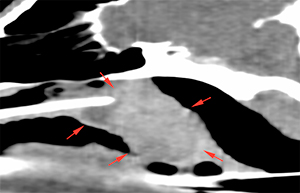

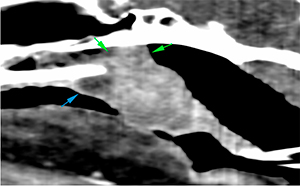
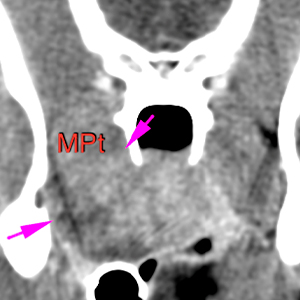
In addition, the mass causes mild osteolysis (orange arrows), with minimal irregular periosteal reaction (blue arrow) affecting the caudal portion of the horizontal lamina of the right palatine bone, extending up to the rostral aspect of right pterygoid bone (green arrows).


The portion of the nasopharynx rostral to the mass, as well as both choanae, are obliterated by a soft tissue attenuating, non-contrast enhancing material (consistent with secretion -pink arrows-). The most caudal portion of the nasopharynx is markedly distended with gas.
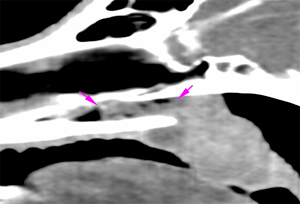
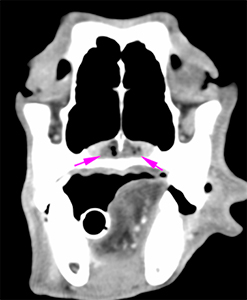
One of the left mandibular lymph nodes is prominent, with presence of a soft tissue attenuating nodule (orange arrow), with mild contrast enhancement, hypoattenuating in comparison to the rest of the lymph node (green arrow). The rest of mandibular lymph nodes are prominent, showing homogeneous contrast enhancement (pink arrows).


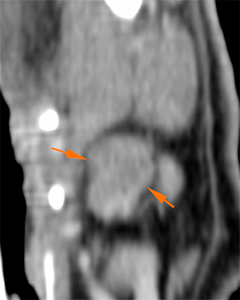

Diagnosis
- Mass affecting the soft palate, with extension to the hard palate, nasopharynx and oropharynx. This mass causes osteolysis of the right palatine and pterygoid bones. These findings are consistent with a neoplastic process (melanoma or squamous cell carcinoma, more likely; others such as round cell neoplasia, less likely).
- Mandibular lymphadenopathy (L>R) most likely metastatic
Comments
Sampling of the mass and affected lymph nodes is recommended in order to reach a definitive diagnosis.

No comment yet, add your voice below!